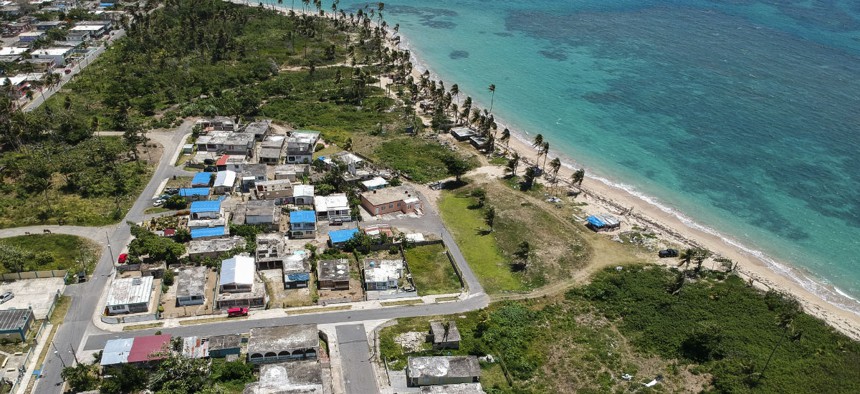
Blue tarps cover homes in Puerto Rico that were still damaged nine months after Hurricane Maria hit. Dennis M. Rivera / AP
FEMA Acknowledges Flaws in Puerto Rico Post-Hurricane Effort
After-action report on triple disaster calls for clearer roles and more certified staff members.
In stark contrast to President Trump’s upbeat tweet last September claiming a “great job” and “massive food and water delivered,” the Federal Emergency Management Agency on Thursday acknowledged that it could have been better prepared for the surprisingly vast needs following Hurricane Maria’s destruction of much of Puerto Rico last fall.
In a 60-page after-action report on the 2017 hurricane season that also devastated parts of Florida, Texas and Louisiana and caused $265 billion in damage, the agency documented how it lacked adequate numbers of disaster certified staff and a clarity of roles vis-à-vis partner entities. “FEMA could have better leveraged open-source information and preparedness data, such as capability assessments and exercise findings, for Puerto Rico and the U.S. Virgin Islands,” the report said.
Numbers in the report demonstrate that Puerto Rico—whose residents have expressed bitterness toward the Trump administration for its follow-up to the disaster—suffered an average wait time of 39 days for supplies. That’s in contrast to shorter wait times for deliveries made to mainland locations following previous hurricanes Katrina, Rita, Wilma, Sandy, Harvey and Irma. FEMA during the same 2017 season was able to get supplies to victims of Harvey in 24 days and Irma in 27 days. Puerto Ricans also experienced fewer inspections for damage.
One reason for the differing responses was poor luck and simple overload (wildfires in California added to the pressure from multiple storms). “In response to Hurricane Irma impacts, FEMA distributed more than 80 percent of its inventory for selected commodities from the Caribbean Distribution Center warehouse,” report noted. “Hurricane Maria struck before supplies were replenished.”
But FEMA also acknowledged that it needs to restructure its operations. The agency “is constantly reviewing its program delivery, decision-making processes, and responses to ensure that we can improve, minimize errors, and better serve survivors,” Administrator Brock Long wrote. “FEMA calls on its federal, whole community, and [state and local] partners to work to transform emergency management so that, together, we can innovate and implement new approaches and technology, reduce complexity, increase efficiency and improve outcomes for survivors and affected communities after a disaster.”
The report includes 18 findings and related recommendations, noting that FEMA leaders at all levels have already made adjustments, focusing on revising its National Response Framework and its Federal Interagency Operational Plan. “Collectively, we must continue to simplify our processes and leverage new approaches and technology to reduce complexity and increase efficiency, focusing on outcome-based recovery,” Long said. “FEMA needs to simplify the process of applying for assistance to make our programs easier to navigate.”
Before the hurricanes, 56 percent of FEMA workers were certified; now it is up to 62 percent. FEMA’s force strength has risen from 10,683 to 11,476, and those deployed to Puerto Rico rose from 2,805 to 2,997. (Force strength is the actual number within FEMA’s larger workforce who have completed administrative requirements for deployment following incidents.)
Among the recommendations are working on grantmaking to provide emergency housing options, and improving cooperation with agencies such as the Housing and Urban Development Department and the Army Corps of Engineers.
In a response on Thursday, Homeland Security Secretary Kirstjen Nielsen said, “By capturing the insights gained from the previous hurricane season, this report, which is focused only on the efforts of DHS and FEMA, provides a transformative roadmap for how we respond to future catastrophic incidents in support of states, tribes and territories. No two disasters are alike and each requires the first responders on the ground, as well as federal support, to adapt to the unique circumstances and needs in real-time. With every response or recovery effort, we take with us lessons learned that help build a nation-wide culture of preparedness and shape the way FEMA and the emergency management community respond to and recover from future disasters.”







